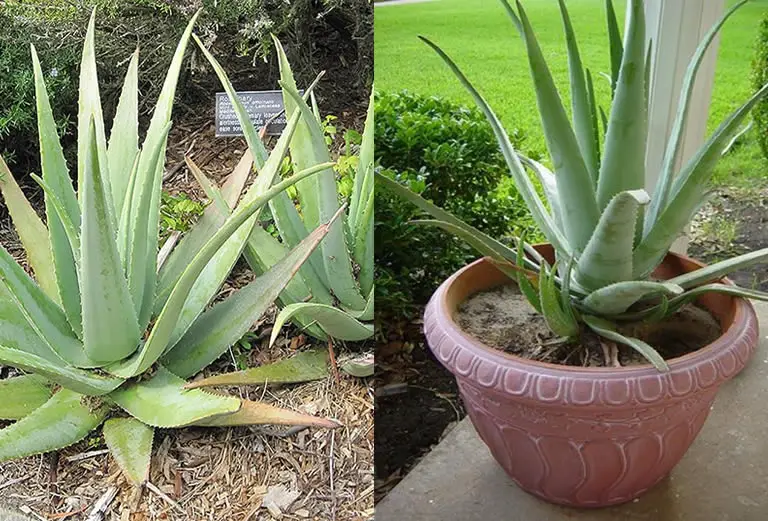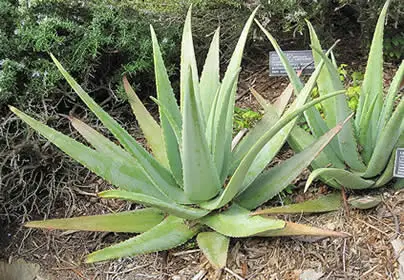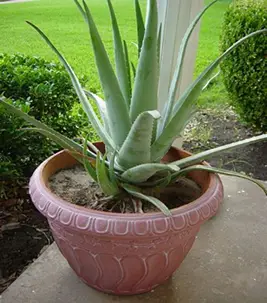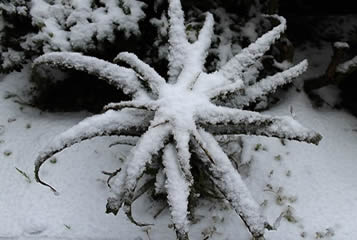The Ultimate Guide To Growing & Taking Aloe Plants Outside

In this article I cover everything you need to know about using aloe plants outside. This includes the very popular aloe vera plant. I outline in what areas of the country you can grow aloe outside as a garden plant, or outdoor potted plant, and when it should never be grown outdoors.
Below I also cover the key aspects of taking aloe houseplants outside, such as when it is ok to move an aloe houseplant outside and also when it should never be left outside.
I also show where an aloe plant should be positioned outdoors and the conditions necessary for healthy growth and strong blooms.
Table of Contents
Guide to using aloe plants outside – yard plants and houseplants
To understand if an aloe plant can be grown outside you need to know what the care requirements are for the plant.
Aloe plants are perennial succulents that can bloom year-on-year for decades. They grow naturally in warm, dry climates that are desert-like.
This means aloe plants require more direct sunlight that many other popular houseplants in order to grow and bloom.
An aloe plant needs at the very least 6 hours per day of strong direct sunlight.
Many houseplant owners never experience the flowering of their plants. This is simply because their plant never gets enough direct sunlight to give it enough resources to bloom (see our aloe sun and light requirements guide).
So does this mean that you should move your plant outside as it will obviously get more direct sunlight sitting in the yard than it would in a room in your home?
Although moving an aloe plant outside will, in many cases, mean the plant gets more sunlight, as a desert succulent it may not be a great idea to try to grow aloe plants outside in certain parts of the country.
No is it a good idea to move your aloe houseplant outdoors if you don’t live in an area that gets the correct conditions for this plant.
Let’s take a look at what outdoor conditions an aloe plant needs in order to grow and thrive.
Growing aloe plants outside as a yard plant
Aloe are tropical and subtropical plants that are not suitable for outdoor cultivation in many areas across the US (and in no areas in the UK).
As a desert succulent that grows naturally in the tropical and subtropical parts of the African continent.
It also grows in countries such as Madagascar, the Arabian Peninsula, Jordan and some islands in the Indian Ocean like Comoros, Réunion and Mauritius, the aloe plant plant is best suited to warm and dry climates.
Aloe needs very specific conditions in order to thrive, It requires the correct soil and temperature as well as the correct amount of water and nutrients.
If any of these elements are are not within the proper range an aloe plant can suffer.
To understand the needs of this plant and how they relate to your local outdoor environment I will briefly cover the most important aspects of the plant’s growth requirements.

With summer temperatures that can rise to 80°F in an aloe plant’s natural habitat (in some extreme cases as high as 90°F ) these flowering perennials have evolved to need warmth to survive.
An aloe houseplant can live in almost any home due to the protection it gets from the elements and the fact that households are kept at similar temperatures throughout year – temperatures that are more than adequate for an aloe plant.
An outdoor aloe plant is not so fortunate though.
Being left exposed to the climatic changes that are experienced outdoors and being open to the elements, a yard-grown aloe plant can only be cultivated in specific USDA climate zones.
USDA climate zones 10 and 11 offer aloe plants the best chance of healthy growth outdoors as these zones have dry desert type conditions that are as close to the aloe plant’s natural habitat as you can get in the US.
With dry warm days in the summer and moderate temperatures at night an aloe plant will happily grow in yards in these climate zones.
Like amaryllis, aloe plants can also be grown outdoors in USDA climate zones 8 and 9 but only if given additional winter protection and also protection against rainfall, as aloe plants are scant drinkers.
But, when it comes to growing aloe plants outside, temperature and rainfall are not the only things you need to consider.
Aloe is well adapted to dry conditions and rocky or sandy soil and normal compost-type soil is not a good growing medium for this succulent (see our aloe plant soil guide).
The natural habitat of the aloe plant offers limited water and the soil is not very nutrient rich and is quite sandy.
If have yard soil that is compost-like and heavy in nutrients then it will not be the best growing medium for an aloe plant.
This type of soil will also hold on to too much water for the healthy growth of an aloe plant and if the soil naturally holds on to too much water it will likely kill your plant.
Water logged soil leads to root rot. Read our aloe vera root rot guide for more information on this hazardous condition.
So, although the climate and amount of rainfall are important things to think about when considering whether or not to grow aloe plants in your yard, the soil type of the yard is also very important.
For this reason it is usually best to cultivate an outdoor aloe plant in a pot rather than planting it directly into your garden (unless you live in climate zones 10 or 11).
Where in the US you can grow aloe vera outside year-round
What about the popular aloe plant, aloe vera … can you grow aloe vera outside?
Aloe vera, like all aloe plants, can be grown outside year-round in USDA climate zones 10 and 11.
It can also be grown outside in climate zones 8 and 9 but only with winter protection and protection from rainfall.
Aloe vera can grow outside in the summer in most states.
Yard-grown aloe vera is subject to the same rules that apply to growing any of the other 500 aloe plant species.
As a desert succulent the plant requires warm dry weather. An outdoor aloe vera plant must be protected against low temperatures and heavy rainfall.
For more information about growing an aloe vera outside you should read the entirety of this article.
Where in the garden you should put an aloe yard plant
Now that you know when an aloe plant can be grown outside you need to know where to put it. Where you should you put an aloe plant when growing it outside?
You should place your outdoor aloe plant in an area that gets at least 6 hours of direct light per day.
If the plant gets excessive amounts of strong direct sun and the leaves start to get sun bleached and turn yellow move it to an area that gets between 6 – 8 hours of direct sunlight each day and partial or full shade the rest of the time.
Where possible protect the plant from rainfall.
Bear in mind that aloe plants should only be grown outdoors year-round in climate zones 10 and 11.
Potted aloe plants can be brought outside in summer as long as temperatures do not fall below 40°F.
If the temperatures are warm your biggest concern with the positioning of your aloe plant will be rainfall. Aloe plants should not be given too much water.
They require watering only once every 3 weeks so if your area experiences more rain than this you need to protect the plant from rainfall.
Can I put my aloe plant outside?
Aloe houseplant owners often ask me, “can I put my aloe plant outside?”.
This is a reasonable question as many houseplants are brought outdoors during the summer months.
We you have seen, to grow an aloe plant outside you need to live in the right climate zone.
But what moving your aloe indoor plant outside … is it possible to put your aloe plant outside at certain times of the year?
Aloe houseplants can be brought outside in the summer months in areas where temperatures do not fall below 40°F.
Even in areas that have cold nights an aloe plant can usually be brought outside during warm summer days as long as it is brought indoors at nightfall.
Aloe plants also need to be protected from regular or heavy rainfall when outdoors.
Although the outside temperature is an important consideration when moving an aloe plants outside, it is not the only one.
Water will probably be your biggest concern.
Aloe plants can live on very little water.
Having evolved to grow in dry desert conditions aloe plants can go weeks without being watered (see our aloe plant watering guide).
Too much water can be extremely detrimental to these succulents and in my experience it is overwatering that causes the most common problems with aloe plants.

Just as an aloe houseplant needs to be watered only once every 3 weeks so too should an outdoor aloe plant be watered just as sparingly.
If you live in an area that gets lots of rainfall, or just regular rainfall, even in the warmer months then it is not a good idea to move your indoor aloe plant outside.
At least it is not a good idea to leave it outside when the rain starts to fall.
Not only do aloe plants not like their leaves getting wet (see our aloe plant leaves guide for the proper care requirements of this plant) but too much water can lead to a host of serious problems that are difficult, and sometimes impossible, to fix.
When aloe plants are left to sit in water or heavily water-drenched soil they can quickly develop root rot.
This is often seen as a yellowing of the leaves, a browning of the leaves and can even manifest as a very strong and unpleasant smell that emanates from the plant.
So you don’t want the plant to get any more water than it absolutely needs.
It isn’t always possible to leave a potted aloe plant outside
Now that we know the conditions needed to grow aloe as a yard plant and we now also know when it is possible to bring an aloe houseplant outside (and we we shouldn’t), you may be wondering if a potted aloe plant can survive outdoors year-round.
Can indoor aloe plants live outside?
An indoor aloe plant can only live outside year-round in USDA climate zones 10 and 11.
It can also live outdoors in climate zones 8 and 9 but only with winter and rainwater protection.
An indoor aloe plant can be brought outside in summer in areas where temperatures do not fall below 40°F and there is not a lot of rainfall.
Basically, indoor aloe plants are subject to the same restraints when used outdoors as yard-grown aloe plant because indoor aloe plants are exactly the same as outdoor yard-grown aloe.
The only difference is that the indoor plant is potted.
So, a potted aloe plant is subject to the same restrictions and requires the same care requirements as an aloe that is planted directly into the ground.
This is why I advise people to grow aloe plants in pots simply because it is so much easier to protect the plant from heavy rainfall and low temperatures because you can easily move a potted plant.
Obviously if you live in climate zone 10 or 11 then you can put your aloe plant directly into your yard soil as your environment is naturally well-suited to aloe. But, even gardeners in these zones will often pot the plant rather than plant it directly in the garden.
What happens when you leave aloe plants outside in summer
In most areas of the US an aloe plant can be brought outside in the summer.
Aloe plants can be left outside in the summer in areas that get limited rainfall and that have temperatures that do not fall below 40°F (including night temperatures).
Aloe plants can be yard-planted in climate zones 10 and 11 and left there all summer (and winter).
Aloe plants can be grown in the ground outdoors in the summer in climate zones 8 and 9 but will need removed in winter and potted before being brought indoors.
If an aloe plant is left outside in climates zones 8 and 9 it must be given winter protection in the colder months where temperatures fall below 40°F and and water protection in months where rainfall increases.
What happens when you leave aloe plants outside in winter
The only aloe plants that can be safely left outside in winter are those that are growing in USDA climate zones 10 and 11.
These zones are pretty close to the natural habitat of aloe plants and so leaving the plants outside all-year-round is perfectly fine.
There are gardeners in climate zones 8 and 9 that will cultivate and grow aloe plants outdoors, directly in the garden, but they will always provide winter protection for the plants when the colder and wetter months roll in.
More often than not the aloe plants will be removed from the garden and potted in these zones, before being brought indoors as low temperatures are not the only hazard of winter.
Rainfall and frost are also big problems for aloe plants.

The two most important things to remember when growing aloe plants outdoors is temperature and precipitation.
Aloe are tropical and subtropical plants that like warm, dry air, sandy soil and do they do not like to get wet preferring to drink from the bottom rather than the top.
Aloe plants will die if left in freezing temperatures and if left in water-drenched soil or if given too much water.
Where outside you should put an aloe vera houseplant
Aloe vera plants are often grown in the US (and other countries) for their latex. When you cut an aloe leaf it will ooze its inner gel and this aloe latex is used in many household skin care and hair products.
So many gardeners want to know where to position their aloe vera plants outside to get the best foliage growth for latex harvesting.
An aloe vera plant that is usually kept inside, but that you want to keep outdoors during the warmer months, should be placed in a spot that gets at least 6 hours of direct sunlight per day.
It should be protected from rainfall as these plants only require watering only every 3 weeks.
Protect the aloe vera from very strong and prolonged sunlight.
If the plant receives too much prolonged strong sun, and the leaves bleach yellow, move the plant to an area that gets less strong light. 6 – 8 hours of direct sun during the day and partial or full shade the rest of the day is best.
Your main concern when placing an aloe vera houseplant outside is the amount of water it will receive from rainfall.
Even in summer rainfall is still common in many parts of the US and although the temperatures will be fine for growing aloe vera the amount of rainfall will not be.
So, wherever you put the plant be sure it is protected from the rain while still getting plenty of direct sunlight.
This is why it is a good idea to always grow aloe vera in a pot so it can be easily moved – unless you live in climate zones 10 or 11 that are perfect for growing aloe vera directly into the yard soil.
Thanks for reading! I'm Michael — houseplant fanatic and your Pinterest plant guide.
Follow me on Pinterest for fresh updates 🌿



